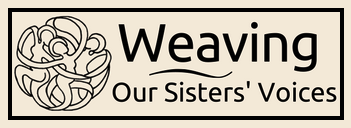Comments from Dr. Elizabeth Goldstein
"I have the privilege of teaching Hebrew Bible alongside Dr. Schearing in the department of Religious Studies at Gonzaga University, and every semester I have taught many of the stories told in Weaving Our Sisters’ Voices. However, I often teach them in a historical context, with some time devoted to their literary forms and structures, and some time devoted to how people utilize these stories today in different religious and political contexts. What I can’t do very often is give my students a chance to feel the characters of the biblical stories—and this is in fact the gift that Dr. Schearing has given the actors and audiences who participate in this script.
"What I love about Dr. Schearing’s script is the attention to detail. She knows the Bible inside and out and her exploration of these stories is brilliant because she knows exactly what the text says and what it doesn’t say. The content of what she fills in does not contradict the general trajectory of the narrative, but instead gives shape and rounds out missing pieces (the missing pieces being the extended voices of the women) giving voice to things we can identify with today.
"What Dr. Schearing is doing is participating in an age-old phenomenon. She is doing what we call in Jewish Studies, “midrash.” Midrash is a Hebrew word that means to interpret or explain, particularly in the context of examining the meaning of a text. Traditionally, midrash from the 1st to 6th centuries of the Common Era assumes that every word of the Pentateuch, or Torah, is the word of God and that we are dealing with a fixed text. However, there is a theological assumption that when God gave the Torah to Moses on Sinai, there were spaces between the words, so that human beings (who would change and evolve over time) would be able to add additional meanings. These interpretations are not made up or fake. Rather, they constitute God’s own intention—we call it the “Oral Torah.’ The Oral Torah has as much as or perhaps even more significance than the Written Torah. Of course, there are rules that dictate what constitutes Oral Torah, but certainly midrashic writing would be defined as Oral Torah. One of the rules of writing midrash is that it can’t overtly contradict the biblical text.
"An example of how midrash works, from what we see in the script, is the sense of foreboding expressed by the characters in the telling of the Concubine of Gibeah. While the biblical text says that the woman left her husband to return to her father’s house, the narrator reveals that she is fleeing because she is being mistreated. One can assume that she is mistreated because otherwise a woman in Ancient Israel would not undertake such a dangerous journey, nor would she give up a solid place in a household, even if it is a second or third place. Schearing’s midrash gives voice to what the text insinuates but could be overlooked, especially in a story that is so disturbing, and seemingly less relevant for today.
"What I appreciate most about Dr. Schearing’s array of midrashic interpretations is that she conforms to the traditional rules for writing midrash, and adds many levels of meaning that make these stories so much more relevant for our own day. Schearing is also a solid Scripture scholar and teaches us about the historical context of these narratives even as she provides a new lens through which to view them."
